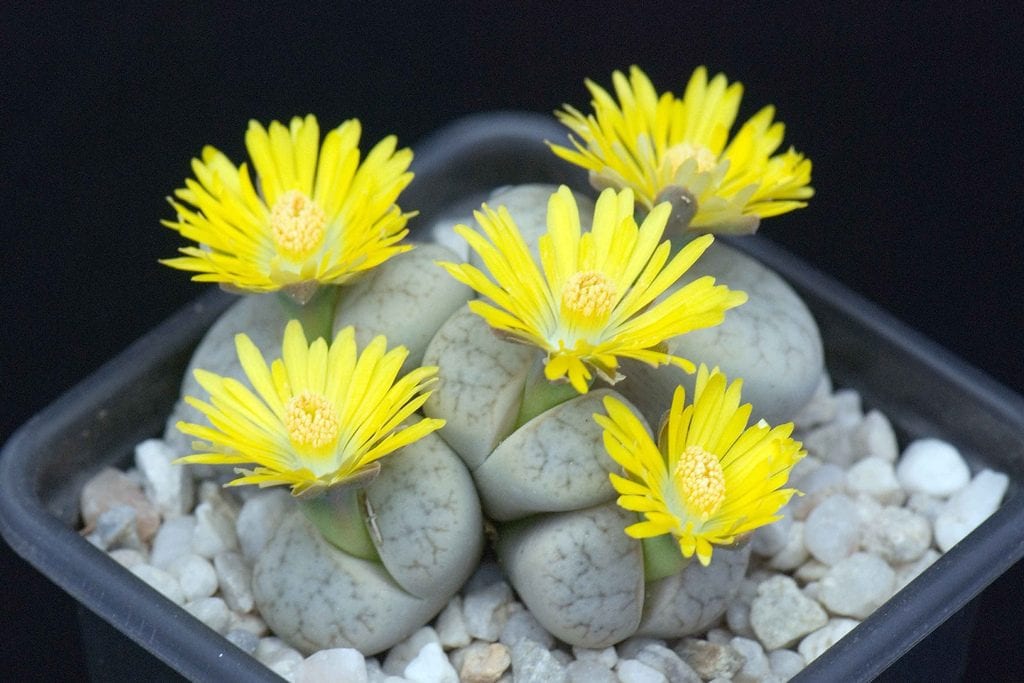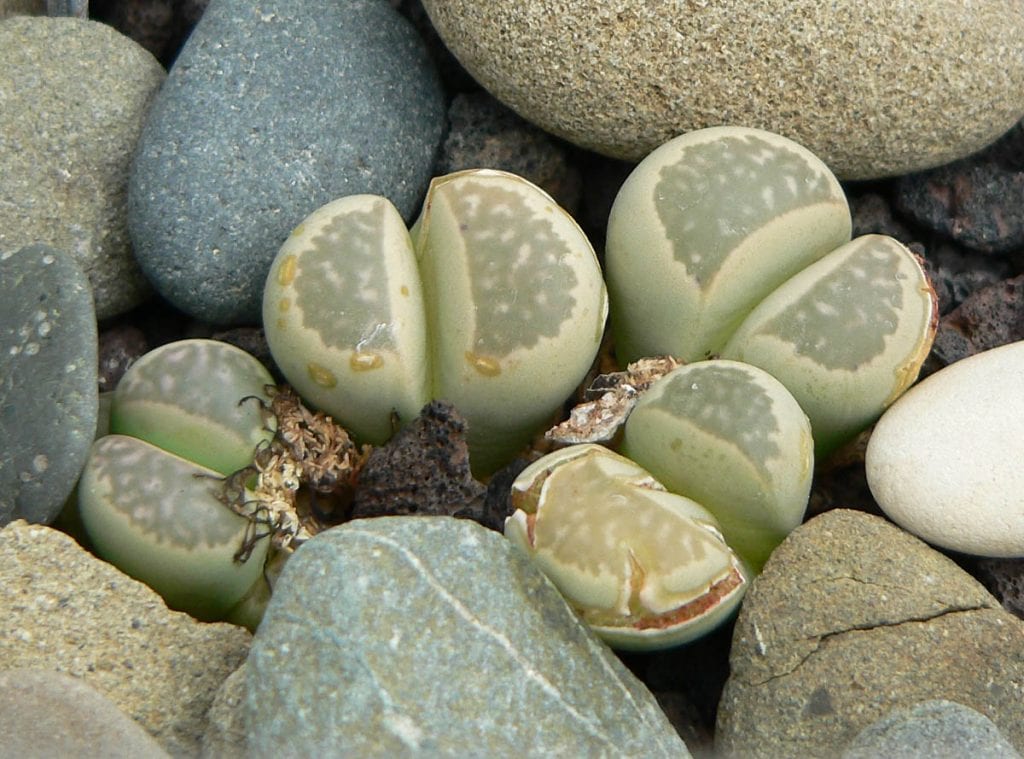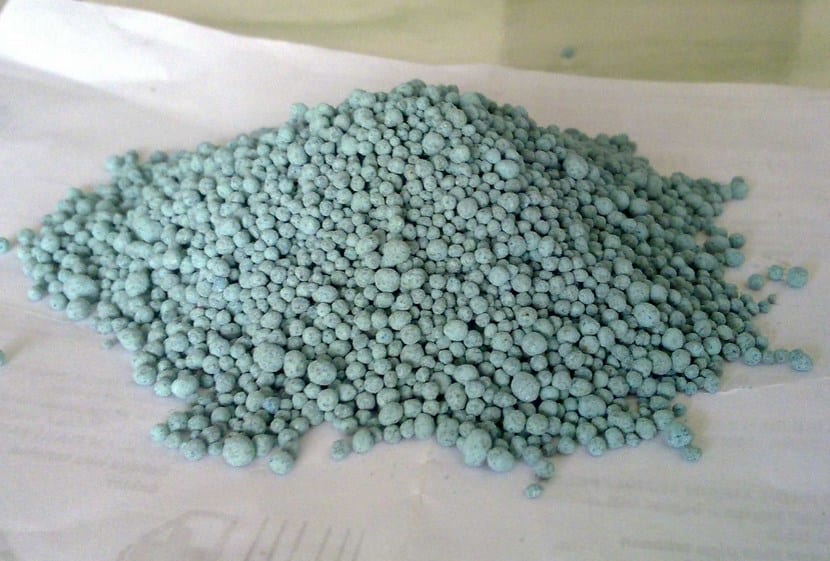
Lithops weberi
The lithops they are perfect succulent plants to have in the patio or on the terrace: measuring about 4-5cm in height by 1-2cm in width, they can be grown in pots throughout their life and, in fact, if they were planted in the garden we will most likely end up losing them.
Although it is often thought that they are very demanding, in reality they are not so demanding. If you don't believe me, you just have to test the tips and tricks that I'm going to offer you in this special, and then if you want, tell me how it went.
Lithops characteristics

Lithops herrei
Our protagonists are plants native to southern Africa. The genus, Lithops, comprises 109 species belonging to the botanical family Aizoaceae. They are known by the common names of living stones, living rocks or stone plants since that is precisely what they seem: stones found in the sandy desert. They are also called stone cacti or lithops cacti, although they are not cacti, but non-cacti succulents.
These curious plant form groups of two coupled fleshy leaves divided only by a fissure where the flowers appear, and also the new pair of leaves as the »old» withers away. Depending on the species, their color can be pink, purple, green; spotted, stippled, or striated.
The flowers open in the fall, towards sunset. They are very reminiscent of those of daisies, although the petals are much thinner (less than 0,5cm thick). They are slightly larger than the body of the plants, and have a very beautiful yellow or white color.
They are considered window plants, since in their leaves they have a translucent zone, without chlorophyll, through which the sunlight reaches the part that is buried.
How are they cared for?

Lithops karasmontana v. lerichana
If you dare to buy one or more copies, here is your care guide:
Location
Place your Lithops in an area where sunlight hits them directly, ideally throughout the day. Ideally, they should be outside, since indoors they tend to have problems due to lack of light.
Substratum
The substrate must have very good drainage. The roots do not support waterlogging, so it is highly recommended to use sandy substratesas akadama, river sand or pumice.
Irrigation
When do you have to water?
Watering is the most important and complicated task at the same time that you have to do when you have plants. With lithops it is not easy to know when to water, although we can do some things to avoid overwatering:
- One is take the pot once watered, and again after a few days. The wet substrate weighs more than when it is dry, so we will only have to memorize the weight it has in each of the situations to know more or less when it is time to water.
- Alternatively introduce a humidity meter. As soon as we introduce it, it will tell us if it is wet or dry, but to be more reliable it is important to introduce it again in other areas (near the plant, away from it) because normally the substrate is usually more humid right around the plant than near from the edge of the pot.
What water to use?
The most suitable irrigation water is rainwaterBut since we can't always get it, we can fill a bucket with tap water and let it sit overnight. The next day we will water with the water from the upper half of the bucket.
Irrigation in winter
In winter the lithops are at rest. This means that their growth is practically zero, and their water needs decrease. Due to the meteorological conditions, the substrate remains humid for a longer time, so we have to reduce the frequency of watering.
Generally, we will water once every 15 or 20 days, always taking into account the humidity of the substrate and the weather forecasts.
Subscriber

The subscriber is very important for them to grow healthy. For this reason, throughout the growing season (spring and summer) they must be fertilized with mineral fertilizers, either specifically formulated for cacti and succulents, or with Nitrofoska by adding a small spoonful once every 15 days.
Transplant
Being small plants it will be enough to pass them to a somewhat larger pot when we buy them. If we acquire them in autumn or winter, we will transplant them in spring, when the risk of frost has passed and the temperatures, both minimum and maximum, begin to remain above 15ºC.
Problems
Basically three problems can arise in cultivation: lack of light, rotting and a plague of snails.
Lack of light
If they lack light, the new leaves will grow higher than normal, thus weakening the plants. To avoid or fix it, they must be located in an area where direct sunlight hits them.
Decay
If it has been overwatered, or if the substrate has very poor drainage, the leaves will rot and die. To avoid it, it is very important to use well-drained substrates and to water very occasionally, Especially in winter.
Sea Conches
Snails and slugs are mollusks that love these plants. To prevent them from killing them, the quickest and most effective way is to put a few grains of molluscicide in the pots.
If you want to try natural remedies, you will find more information about them in this article.
Multiplication
To get new specimens, it is necessary to have two or more lithops that bloom at the same time, a brush and an area protected from the wind. Once you have, you have to pass the brush first through a flower of a plant and, immediately afterwards, by another flower of another plant. If all goes well, the last flower will have been pollinated and the seeds will begin to grow, which are sown once they mature in pots with vermiculite and placed in the sun.
Rusticity
Lithops are plants that are very sensitive to cold, especially hail and snowfall. They can withstand weak and occasional frosts of up to -2ºC, but the substrate must be dry. In the case of living in an area where winters are colder, it is convenient to place them inside a greenhouse, or inside the house in a room where a lot of light enters, for example near a window and protected from drafts. (both cold and warm).

Lithops lesliei
What do you think of these plants?
Good afternoon, I have a question about the best way to germinate lithops seeds
Hi samuel.
Lithops seeds are sown in a tray or pot with holes filled with vermiculite.
It is not necessary to cover them, but it is recommended to do so if the wind usually blows with some regularity.
Water them with a sprayer, and they will germinate in a short time at a temperature of 20-25ºC.
A greeting.
How do they behave in Santa Marta?
Hi Yanneth.
Where are you from? We write from Spain 🙂
However, if there is no frost and it is in full sun, they will grow well.
A greeting.
Üdvözlöm! Hol lehet venni Lithops magokat?
Hi Erika.
You can get Lithops seeds on ebay or in online stores.
A greeting.
Hello motherland! I'm from Uruguay !
I loved the page, everything is explained and in a highly detailed and easy to understand way. I have just started with Lithops and I see that my experience with cacti and succulents will be useful to me, but for example, the multiplication is totally different.
Thanks a lot !
Thanks for your words, Sylvia. Greetings from Spain 🙂
Very complete information
I would like to know if they can live in a constantly cold climate, as you know we do not have seasons here in Colombia and because where I live, summer lasts very little and it rains constantly
I thank you in advance for answering
Hello Cristian.
No, Lithops prefer a warm climate. 🙁
A greeting from Spain.
Hi Monica, greetings from Puerto Rico. I have not had that luck with the seeds, it seems that I do not have that gift of growing Lithops. I would like to know where to get the Lithops in the plant to see if I am lucky that way.
Hello Sunday.
I couldn't tell you, because we wrote from Spain.
But you will almost certainly find them for sale in nurseries and garden stores.
A greeting.
How are they behaving in central Mexico? in Summer the average temperature is 34ºC and in Winter 16ºC
Hello Yaroslav.
They can work very well 🙂
A greeting.
Why won't my Lithops grow? It does not have that characteristic aspect of succulents, every time I see it smaller it seems that it is drying. I have it indoors, the sun does not shine directly but there is enough sunlight, I water it approximately every 20 days. I don't know what else to do, I don't want to lose it.
Hello Lulu.
I would advise you to water it once a week in summer and every 20 days the rest of the year.
It is also important to pay it in spring and summer with a liquid fertilizer for cacti and other succulents following the instructions specified on the package.
A greeting.
Hello, I am from Uruguay and I have been trying to germinate Lithops seeds bought in different places for months but they do not germinate. Now we enter Spring and I continue to take care of them both with the humidity, light and temperature, although at night at this time it drops to 10 degrees and in the day between 18 and 20 degrees. I have sprouts to give heat and if it is colder I put them, but zero success. Is it possible for more in late spring to germinate? Since weeks have passed and they don't germinate, I uncover them a bit so they don't catch fungus. Will it be the climate of my country? On the other hand, I have bought Lithops plants that are doing well, my problem is with the seeds. You have any idea what could happen, because it is not logical that all the seeds are bad. Needless to say, I put some of them on cotton, others on kitchen paper and others on the ground, but in neither case was I lucky. Thank you for your advice
Hello, Martha.
It may be the soil you use for the seeds. I would recommend using black peat with a lot of pearlite, and on top of it, put pumice or other volcanic sand. That way they should germinate well at those temperatures.
A greeting.
Good afternoon.
I am from Colombia and at this time we are in summer I love the Gardens, especially I collect succulents, at this time I buy some Lithops seeds online for free market and I sowed them with black peat and volcanic sand, they are in a place where it gives them a lot of heat (25º to 30º) but not direct by the wind, my question is how long (days) should I wait for germination?
Thank you.
Hello good, the ph of irrigation I imagine that the same as in cactus and succus? 5,5 variable up to 6?
Hi Jamie.
Well look, I'm watering them with a pH of 7 water and no problem 🙂
5,5 to 6 is somewhat acidic for succulents, both cacti and succulents.
A greeting.